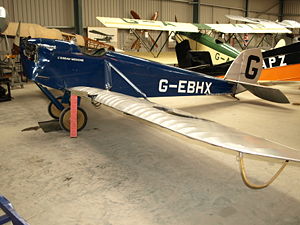de Havilland DH.53 Humming Bird
| DH.53 Humming Bird | |
|---|---|
 | |
| General information | |
| Type | Ultralight monoplane |
| Manufacturer | de Havilland |
| Primary user | Royal Air Force |
| Number built | 15 |
| History | |
| Manufactured | 1923–1924 |
| First flight | 2 October 1923[1] |
The de Havilland DH.53 Humming Bird is a British single-seat, single-engine, low-wing monoplane light aircraft first flown in the 1920s.
Design and development
In response to the Daily Mail Light Aeroplane Competition of 1923 de Havilland built two DH.53s which were named Humming Bird and Sylvia II. The DH.53 was a low-wing single-seat monoplane powered by a Douglas 750 cc (46 cu in) motorcycle engine. At Lympne, in October 1923, the DH.53s did not win any prizes but gave an impressive performance.[2] After the trial, Humming Bird was reengined with a 26 hp (19 kW) Blackburne Tomtit two-cylinder engine, and the aircraft was fitted with a revised undercarriage.[2] The Air Ministry became interested in the design and ordered eight Tomtit-powered aircraft in 1924 as communications and training aircraft for the Royal Air Force.[3]
Early in 1924 twelve aircraft were built at Stag Lane Aerodrome and were named Humming Bird after the first prototype. Eight aircraft were for the Air Ministry order, three were for export to Australia, and one was exported to Avia in Prague. One further aircraft was later built for an order from Russia.[4]
Operational service

The first six aircraft for the Royal Air Force all made their public debut at the 1925 display at RAF Hendon, where they were raced against each other. The last two aircraft would later be used for "parasite aircraft" trials being launched from below an airship – the R.33. The aircraft were retired in 1927 and all eight were sold as civil aircraft.[5]
Operators
Aircraft on display
- G-EBHX, the prototype, was airworthy and on display at the Shuttleworth Collection, but crashed on 1 July 2012, killing the pilot.[6][7][8] The airframe has since been rebuilt to airworthy condition and was returned to the Shuttleworth Collection in 2020 for completion.[9]
- J7326 fuselage is on display at the de Havilland Aircraft Heritage Centre.
Specifications
Data from British Civil Aircraft since 1919 Vol 2,[10]
General characteristics
- Crew: 1
- Length: 19 ft 8 in (5.99 m)
- Wingspan: 30 ft 1 in (9.17 m)
- Height: 7 ft 3 in (2.21 m)
- Wing area: 125 sq ft (11.6 m2)
- Airfoil: RAF 15 modified[11]
- Empty weight: 326 lb (148 kg)
- Gross weight: 565 lb (256 kg)
- Powerplant: 1 × Blackburne Tomtit V-2 inverted air-cooled piston engine, 26 hp (19 kW)
- Propellers: 2-bladed fixed-pitch propeller
Performance
- Maximum speed: 73 mph (117 km/h, 63 kn)
- Cruise speed: 60 mph (97 km/h, 52 kn)
- Range: 130 mi (210 km, 110 nmi)
- Service ceiling: 15,000 ft (4,600 m)
- Rate of climb: 225 ft/min (1.14 m/s)
- Wing loading: 4.52 lb/sq ft (22.1 kg/m2)
- Power/mass: 0.046 hp/lb (0.076 kW/kg)
See also
Related development
Related lists
References
Citations
- ^ Jackson 1987, p. 208.
- ^ a b Jackson 1987, p. 203.
- ^ Jackson 1987, p. 204.
- ^ Jackson 1987, pp. 204–205
- ^ Jackson 1987, p. 206.
- ^ "BBC News – Pilot dies after vintage plane crashes in Bedfordshire". BBC News. July 2012. Retrieved 1 July 2012.
- ^ Niles, Russ (1 July 2012). "Pilots Killed In Airshow Crashes". AVweb. Retrieved 2 July 2012.
- ^ De Havilland DH53 Humming Bird, G-EBHX, 1 July 2012, Air Accidents Investigation Branch, 10 December 2014
- ^ "DH Hummingbird G-EBHX". Sovereign Restorations.
- ^ Jackson 1973, p. 77.
- ^ Lednicer, David. "The Incomplete Guide to Airfoil Usage". m-selig.ae.illinois.edu. Retrieved 16 April 2019.
